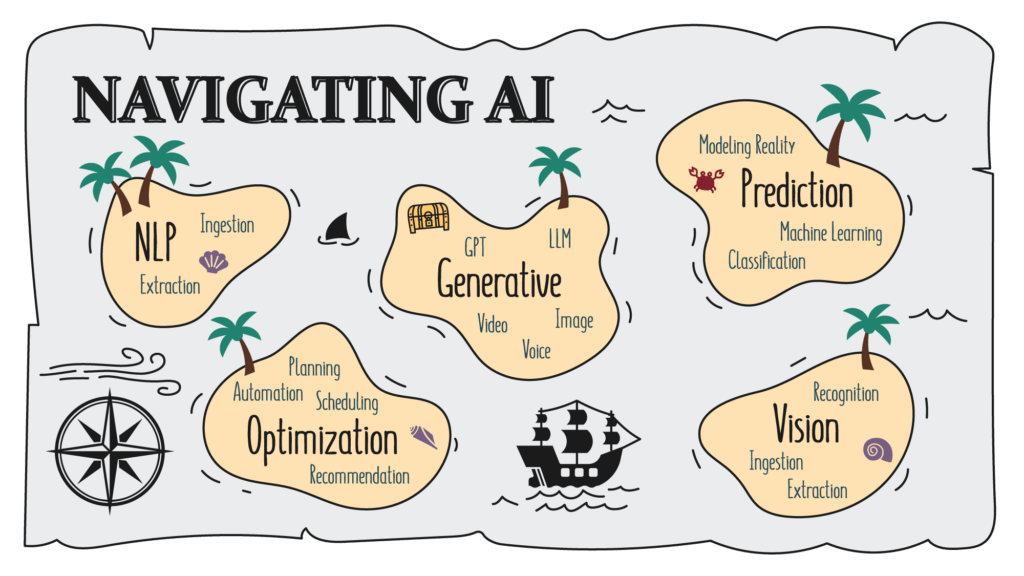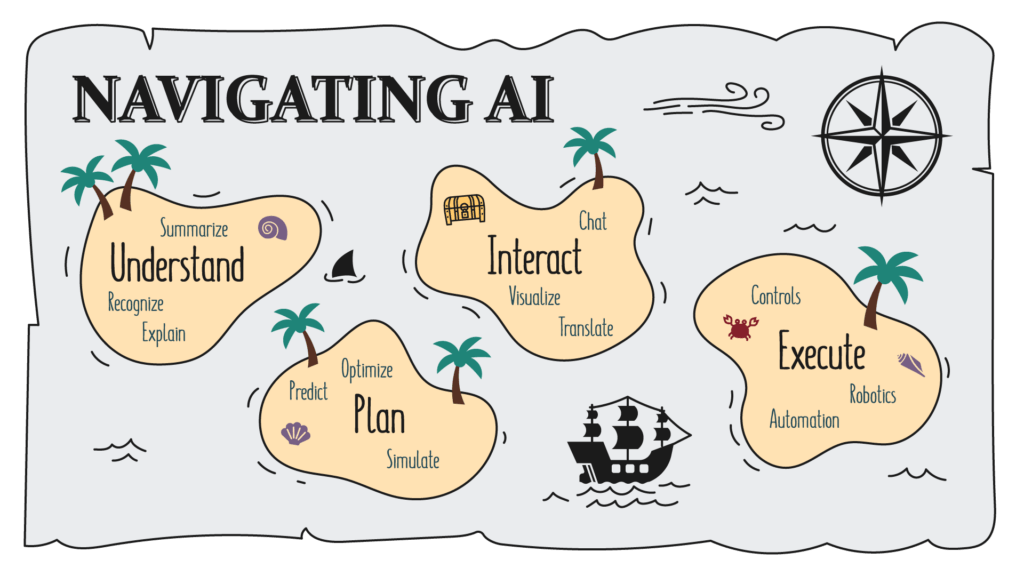This post originally appeared on SEP’s Blog
Successfully deploying AI needs more than enthusiasm. You need to know when to use AI, and what kind of AI to reach for when it’s appropriate.
AI Isn’t a Tool, It’s a Toolbox

We like to think of AI as a well stocked tool box, broken into five broad subfields, each designed for different kinds of problems:
- Generative AI
Systems that create new content, such as text, images, code, even music. These are your ChatGPTs and StableDiffusions, but also the fine-tuned models generating custom legal clauses or customer support answers. - Computer Vision
Techniques for understanding images and video. Everything from detecting defects on an assembly line to evaluating the correctness physical therapy motions conducted by a patient in a remote location without nearby providers. - Natural Language Processing (NLP)
Tools for understanding and generating human language in structured ways. Things like entity extraction, summarization, and sentiment analysis. - Prediction (Machine Learning)
Algorithms that learn patterns from historical data to make future guesses. These do things like forecasting sales or identifying churn risks. - Optimization
Techniques that help systems make the best decision under constraints, whether it’s scheduling deliveries or allocating limited resources.
Now, could you use a generative model to solve an optimization problem? Sometimes. But purpose-built tools tend to yield better, faster, and more interpretable outcomes. Like any good craftsperson, you want to reach for the right wrench, not just the trendiest one.
The Verbs That Lead to AI
When someone says “we want to use AI,” what they usually mean is something more specific, but less well-formed. We hear it all the time in early conversations:
We want to understand what’s going on in this system.
We want it to interact with users.
We need a way to plan ahead.
We want to automate execution.

These verbs, Understand, Interact, Plan, and Execute, are the first signals that AI might help. And they map surprisingly well to the AI toolbox:
| Verb | AI Subfields Most Often Involved |
|---|---|
| Understand | Prediction, Vision, Generative |
| Plan | Optimization |
| Interact | NLP, Generative |
| Execute | Optimization, Generative |
This mapping gives us a shared language for talking about real-world needs and technical possibilities. A more complete mapping of verbs that provide a hint that AI might be waiting in the wings is provided below:
Mapping Needs to Capabilities
Let’s look at how these verbs show up in real-world projects, and what kinds of AI approaches are best suited to each. The following examples are drawn from use cases that I’ve worked on over the course of my career.
Understand
When you’re trying to make sense of a messy system or dataset:
- Predictive maintenance for turbine engines, where the goal is to forecast failure before it happens.
- Infrastructure decay prediction, where ML helps city planners estimate how roads will degrade year over year.
These problems are often solved with a blend of prediction, vision, and sometimes generative approaches for summarization or reporting.
Plan
When your system needs to figure out what to do under constraints:
- Municipal budget allocation for highway maintenance, balancing fairness, urgency, and cost.
- Optimizing Patterns on Raw Material, deciding how to pack templates onto fabric or metal to minimize wasted material.
This is the heartland of optimization, where the best solution isn’t just likely, it’s mathematically provable.
Interact
When your system needs to talk with humans:
- Agentic assistants helping researchers explore new findings in science or business.
- RAG systems (retrieval-augmented generation) pulling from internal documents to answer employee questions.
These blend NLP and generative models to support richer, more reliable human-machine conversations.
Execute
When the rubber meets the road—and the system needs to act:
- Automation of controls in an industrial lumbermill to maximize throughput without compromising safety.
- Robot arm programming for manufacturing lines, where speed, precision, and adaptability matter.
Here, optimization ensures efficiency, while generative models may help create adaptable motion plans or fallback strategies.
Avoiding “Accidental AI”
The biggest mistake we see? Teams fall in love with a particular tool, usually the newest, flashiest one, and try to force it into every problem.
We call this Accidental AI: using a generative model where optimization would be faster, cheaper, and better; using a vision model where structured data would do the trick; or overbuilding a chatbot when a report would suffice.
It’s not just wasteful. It’s risky. AI systems that aren’t well-matched to the problem tend to be harder to interpret, harder to maintain, and more likely to fail silently.
Instead, start with the verb. Are you trying to understand something? To interact? To plan or execute? These are all closer tied to the problem that your business is trying to solve. Keeping our thinking closer to the underlying problem results in more fit-to-purpose tools and better outcomes.
Be Intentional, Not Accidental
AI has enormous potential, but only if you know what tool we’re reaching for. Instead of asking “How can we use AI?”, ask:
What do we need to understand, interact with, plan, or execute better than we do today?
At SEP, we’ve helped clients map their needs to the right AI solution for years, long before today’s hype cycle, and we’d love to help your team have that conversation, too.
